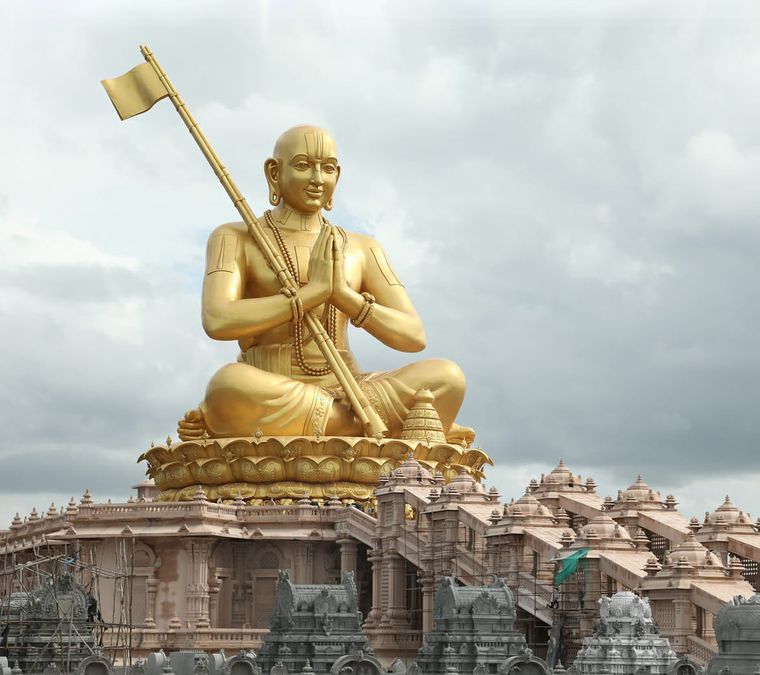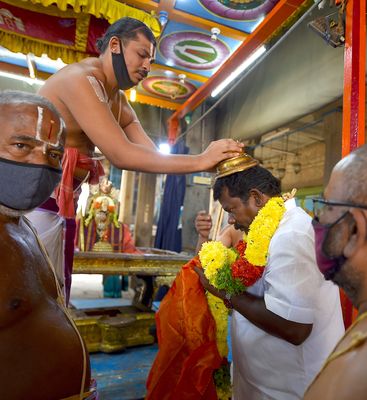PASSENGERS TRAVELLING via the Rajiv Gandhi International Airport in Hyderabad cannot miss the sight of a giant statue of a seated figure holding a flagstaff. This 216ft-tall monument—called the Statue of Equality—built at Srirama Nagaram JIVA Campus, Hyderabad, commemorates the millennium of the birth of saint Ramanuja, a tall figure of the Bhakti movement. Tridandi Chinna Jeeyar Swami, a scholar of Vaishnavism, is the designer and planner of the statue; on September 18, Prime Minister Narendra Modi agreed to inaugurate the statue during the festivities scheduled from February 2 to February 14, 2022.
The saint is revered by a large section of Hindus—both Brahmins and non-Brahmins—from Tamil Nadu. Modi’s first move to appease them was in 2016; he mentioned Ramanuja during his speech from the Red Fort on the 70th Independence Day. The following year, the Union government released a commemorative stamp on the birth anniversary of the saint. The sangh parivar is trying to position itself as the protector of the religion. But the question remains: How would Ramanuja’s teachings of equality of all and his love for Tamil fit into the sangh’s in its Hindi-Hindu-hindutva narrative?
Meanwhile, in Sriperumbudur, Tamil Nadu,—the birthplace of the saint—K. Selvaperunthagai, a dalit legislator from the Congress party, has launched Ramanujar Peravai, a forum to promote the saint’s philosophy. “He [the saint] showed through his life that the oppressed and backward communities were not to be hated and side-lined,” says the Congress leader. The walls of his office near the Rajiv Gandhi memorial are adorned with photos of Periyar—father of the Dravidian movement—Ramanuja and B.R. Ambedkar. “They are revolutionaries and icons of social reform,” says Selvaperunthagai. “Periyar said there is no God. He believed inequality stems from different religions and castes. But Ramanuja was a revolutionary in religion.” The Congressman recounts that his mother used to be a frequent visitor to the Adikesava Perumal Temple (also known as Ramanujar Temple) in Sriperumbudur, which is believed to be the birth spot of Ramanuja.
While Ramanuja is widely worshipped in Tamil Nadu, many atheistic groups in the state see him as a social reformer. “He was a revolutionary saint. He made God accessible to all—through simple love,” says M. R. Srinivasan, a priest at the Ramanujar temple.
Ramanuja is known not only for his philosophical outlook, but also for ushering in significant reforms in religious practices. He wanted temples to be thrown open to all people, irrespective of caste—an idea that faces opposition even these days. Ramanuja’s movement was meant to unite people against conservatism. His Vishishtadvaita philosophy countered and competed with Madhava’s Dvaita (theistic dualism) and Adi Sankara’s Advaita (non-dualism) doctrines. Together, these three formed the greatest
Vedanta philosophies of second millennium.
Selvaperunthagai’s initiative to launch the Ramanujar Peravai, to break the caste barriers and preach equality, has gained support from the followers of Ramanuja. Says S. Kalaiselvi, who has authored books on Ramanuja in Tamil: “I am a staunch follower of Ramanuja; he is my guru. I am a non-Brahmin by birth. But I took Pancha Samskara (five purifications to become Vaishnavite). I want people like Selvaperunthagai to take up and propagate Ramanuja, who travelled across the country to preach his simple philosophy of loving god and liberating human beings.”
The Tamil language was the vehicle that took forward his revolutionary ideas. The Nalaiyra Divyaprabandham—or the 4,000 hymns sung by 12 Alwars (followers of Lord Vishnu), one of the pillars of the Bhakti movement—propagated by Ramanuja, was written in Tamil.
Interestingly, even the Dravidian leaders who toe Periyar’s atheistic line revere Ramanuja. For instance, towards the end of his life, the Dravida Munnetra Kazhagam patriarch M. Karunanidhi had penned a script for a television serial based on Ramanuja’s life. Karunanidhi explained that “the DMK was not against Hinduism, but only against the fundamentalists who arrogated themselves to the role of protectors of religion.”
Political analyst R. Mani says that Karunanidhi may have had a subconscious push to erase a well-entrenched opinion that he was anti-Brahmin. “But whatever may be his unconscious or subconscious outings, the writing of the script for the serial on Ramanuja was a move to say that the DMK was not anti-Hindu,” he says. “Maybe the grand old man of Tamil politics wanted to sign off from public life with a positive contribution to the society by scripting this serial on one of the greatest sons of India.”
Ramanuja’s legacy is seeing a resurrection in the southern state. But, is it just a political game or will anybody heed to his millennium-old call for social harmony and equality?



